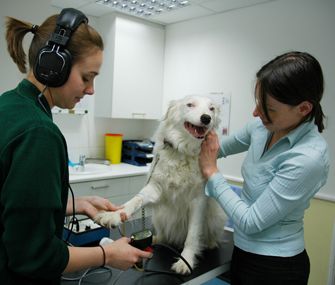Hypertension- Blood Pressure And Your Pets

The most common sign associated with hypertension is vision loss. The retinas are very sensitive to high blood pressure and are usually the first organs to be affected. Unfortunately, a pet cannot communicate a loss in visual acuity, and often a pet owner does not realize this until the pet becomes acutely blind. This is most common in cats. The presenting sign is a cat that was normal one day, and the next has huge dilated, unresponsive pupils, and is bumping into things. Oftentimes once this happens, the retina has detached and the blindness is permanent.
Early diagnosis is key to good control just like in humans. We take it for granted that our blood pressure is measured every time we visit our own physicians, don’t our pets deserve the same? We encourage blood pressure checks in any pet 6 years of age and older at least twice a year, and in any pet that has a disease that is associated with hypertension. We include blood pressure checks in any pet with kidney disease, dilute urine, protein in the urine, Cushings disease, diabetes, and hyperthyroidism. We usually do blood pressure checks after we have the results of the bloodwork. If a cat is diagnosed with hyperthyroidism, we treat that condition first, and oftentimes the blood pressure normalizes.
Blood pressure is measured in pets similarly to humans. A special inflatable cuff is applied to the foreleg of the pet and a series of measurements are taken. We usually take 3-5 blood pressure readings and the average is interpreted. This allows the pet to calm down and minimize the “white coat syndrome”, which can artificially elevate the blood pressure.The most important reading is the systolic blood pressure. We want the systolic blood pressure to be below 160.
Treatment is similar to humans. The underlying disease needs to be controlled. The most common blood pressure medications we use in veterinary medicine are benazepril, enalapril, and amlodipine. These are the same medications we use in human medicine to control hypertension.
Hypertension is common and treatable if diagnosed early. Blood pressure checks should become as routine in veterinary medicine as it is in human medicine.
